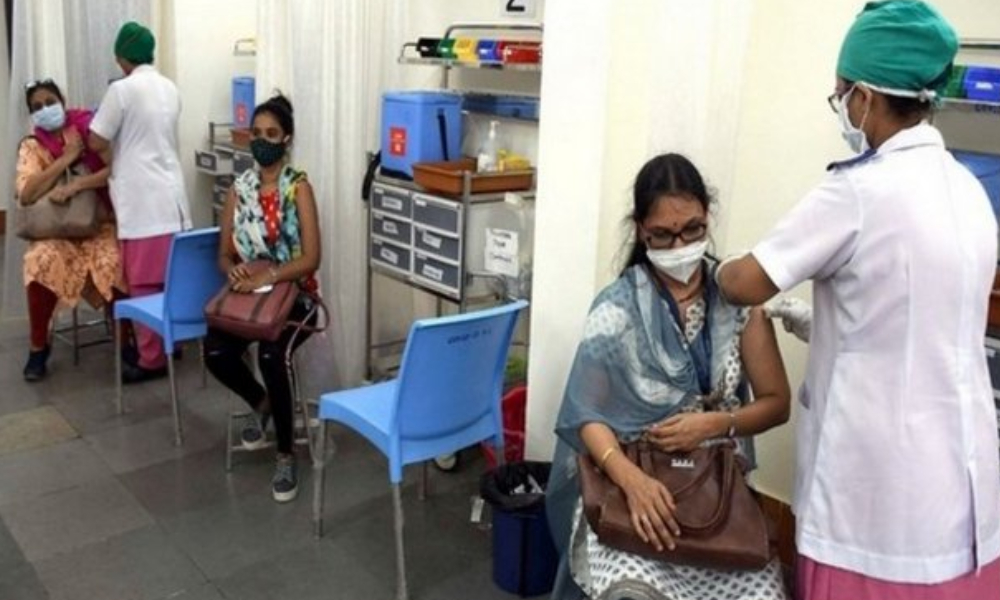
Image Credits: ANI (Representational)
Is Vaccine Hesitancy Plaguing Rural India? Less Than 0.5 % Have Registered
Writer: Prattusa Mallik
A student of Journalism and Audio-Visual Communication, interested in words and silences alike, I aim to bring the narratives of the periphery to the centre, one story at a time. When not working, I'm usually caught reading, thinking, writing, watching Friends, or stargazing.
India, 15 Jun 2021 2:54 PM GMT
Editor : Ankita Singh |
A literature lover who likes delving deeper into a wide range of societal issues and expresses her opinions about the same. Keeps looking for best-read recommendations while enjoying her coffee and tea.
Creatives : Prattusa Mallik
A student of Journalism and Audio-Visual Communication, interested in words and silences alike, I aim to bring the narratives of the periphery to the centre, one story at a time. When not working, I'm usually caught reading, thinking, writing, watching Friends, or stargazing.
Despite an increase in monthly registrations, the widening gap between vaccine registrations in rural and urban India points out the increasing vaccine inequity.
Over 3 lakh Common Service Centres (CSC) across India, assigned to register people in the rural areas for vaccination. As per reports, it accounts for less than 0.5% of the total registrations to date.
Run by the IT Ministry, the CSCs are responsible for delivering the e-Services of the Government of India to the remote villages, where internet availability or computers are almost absent. They have been given the responsibility to register the rural population for vaccines on the CoWIN app more than a month ago.
Less Number of Registrations
There has been 28.5 crore vaccine registration till June 12. Out of these, only 14.25 lakh registrations were made through the CSCs. Uttar Pradesh reported the highest number of registrations via CSCs (5,18,422), followed by Punjab (77,303).
The North-eastern states showed a significantly lesser number of registrations, particularly Manipur (1,165), Meghalaya (1,350), Mizoram (1,258), and Nagaland (1,582). The villages in Union Territories also bear same the testament.
The registrations via CSCs in Andaman and Nicobar Islands, Lakshadweep, Dadra and Nagar Haveli, Daman and Diu, and Ladakh are 57, 39, 58, 68, 10 respectively, reported The Indian Express.
Vaccine Inequity
Despite an increase in monthly registrations, the widening gap between vaccine registrations in rural and urban India points out the increasing vaccine inequity.
According to a report by Reuters, out of almost 176 million people living in 114 of India's least developed districts, only 23 million doses have been administered altogether. Coincidentally, almost the same number of doses have been administered across nine main cities—Bengaluru, Chennai, Hyderabad, Kolkata, Mumbai, Nagpur, New Delhi, Pune, and Thane. However, the combined population of these nine cities is almost half the combined population of the 114 districts.
Earlier this month, The Ministry of Health and Family Welfare had said in a statement, that the vaccine inequity reports in India were "inaccurate and speculative in nature". Now, however, the Ministry of Information and Technology officials have accepted the existence of vaccine inequity in India. However, they are confident that the numbers will increase with the increase in vaccine supply.
Officials also attribute the smaller number of registrations to the myths around vaccination and its pricing, which in turn makes them hesitant about getting vaccinated.
Officials also attribute the smaller number of registrations to the myths around vaccination and its pricing, which in turn makes them hesitant about getting vaccinated.
Possible Reasons: Vaccine Hesitancy
A village-level entrepreneur operating a CSC in Haryana shared that in case, if they ask people to register for vaccination, they ask if vaccines are available. He further added that then tell us that they will return when there are vaccines. He also pointed out that since they have to live with them, they don't push them much to register.
Officials also attribute the smaller number of registrations to the myths around vaccination and its pricing, which in turn makes them hesitant about getting vaccinated.
The rural population accounts for almost 65% of our country. Although urban India, due to its higher population density, accounts for a higher number of cases— rural India has a significantly smaller number of testing. If the problem of vaccine hesitancy adds to it any further, India will never see a steady decline in infection rates.
Also read: Mumbai: Dharavi Reports Zero Case For First Time Since Second Wave Of COVID
 All section
All section














